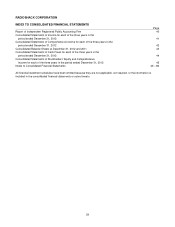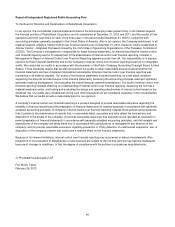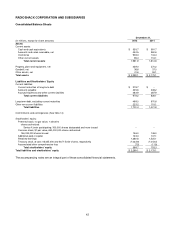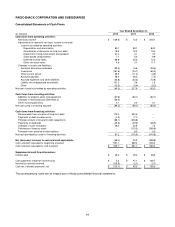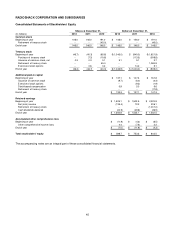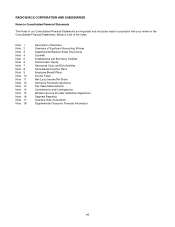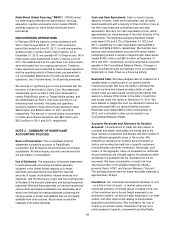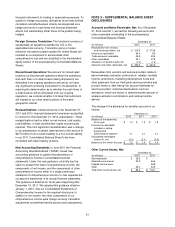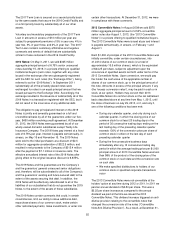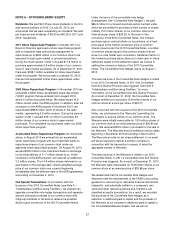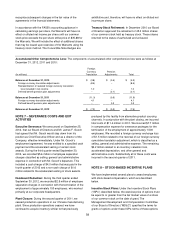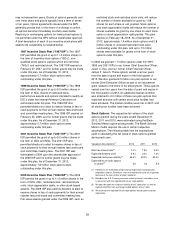Radio Shack 2012 Annual Report Download - page 51
Download and view the complete annual report
Please find page 51 of the 2012 Radio Shack annual report below. You can navigate through the pages in the report by either clicking on the pages listed below, or by using the keyword search tool below to find specific information within the annual report.49
costs to promote a vendor’s products. If the calculated net
realizable value of the inventory is determined to be less
than the recorded cost, a provision is made to reduce the
carrying amount of the inventory to its net realizable value.
To determine market value, we consider the following
items: inventory turnover statistics, current selling prices,
seasonality factors, consumer trends, competitive pricing,
performance of similar products or accessories, planned
promotional incentives, technological obsolescence, and
estimated costs to sell or dispose of merchandise such as
sales commissions.
Property, Plant and Equipment: We present our property,
plant and equipment at cost, less accumulated depreciation
and amortization. Depreciation and amortization are
calculated using the straight-line method over the following
useful lives: 10-40 years for buildings; 2-15 years for
furniture, fixtures, equipment and software; leasehold
improvements are amortized over the shorter of the terms
of the underlying leases, including certain renewal periods,
or the estimated useful lives of the improvements. Major
additions and betterments that substantially extend the
useful life of an asset are capitalized and depreciated.
Expenditures for normal maintenance and repairs are
charged directly to expense as incurred.
Capitalized Software Costs: We capitalize qualifying
costs related to the acquisition or development of internal-
use software. Capitalization of costs begins after the
conceptual formulation stage has been completed.
Capitalized costs are amortized over the estimated useful
life of the software, which ranges between three and five
years. The unamortized balance of capitalized software
costs at December 31, 2012 and 2011, was $39.8 million
and $42.7 million, respectively. Amortization of computer
software was approximately $13.5 million, $12.6 million and
$11.9 million in 2012, 2011 and 2010, respectively.
Impairment of Long-Lived Assets: We review long-lived
assets (primarily property, plant and equipment) held and
used, or to be disposed of, for impairment whenever events
or changes in circumstances indicate that the net book
value of the asset may not be recoverable. Recoverability is
assessed based on estimated undiscounted cash flows
from the useful asset. If the carrying amount of an asset is
not recoverable, we recognize an impairment loss equal to
the amount by which the carrying amount exceeds fair
value. We estimate fair value based on projected future
discounted cash flows. Our policy is to evaluate long-lived
assets for impairment at a store level for retail operations.
Leases: For lease agreements that provide for escalating
rent payments or free-rent occupancy periods, we
recognize rent expense on a straight-line basis over the
non-cancelable lease term and certain option renewal
periods that appear to be reasonably assured at the
inception of the lease term. The lease term commences on
the date we take possession of or control the physical use
of the property. Deferred rent is included in other non-
current liabilities in the Consolidated Balance Sheets.
Goodwill and Intangible Assets: Goodwill represents the
excess of the purchase price over the fair value of net
assets acquired. Goodwill and intangible assets with
indefinite useful lives are reviewed at least annually for
impairment (and in interim periods if certain events occur
indicating that the carrying value of goodwill and intangible
assets may be impaired). We estimate fair values utilizing
valuation methods such as discounted cash flows and
comparable market valuations. We have elected the fourth
quarter to complete our annual goodwill impairment test.
Self-Insurance: We are self-insured for certain claims
relating to workers’ compensation, automobile, property,
employee health care, and general and product liability
claims, although we obtain third-party insurance coverage
to limit our exposure to these claims. We estimate our self-
insured liabilities using historical claims experience and
actuarial assumptions followed in the insurance industry.
Although we believe we have the ability to reasonably
estimate losses related to claims, it is possible that actual
results could differ from recorded self-insurance liabilities.
Income Taxes: Income taxes are accounted for using the
asset and liability method. Deferred taxes are recognized
for the tax consequences of temporary differences by
applying enacted statutory tax rates applicable to future
years to differences between the financial statement
carrying amounts and the tax bases of existing assets and
liabilities. The effect on deferred taxes of a change in tax
rates is recognized in income in the period that includes the
enactment date. We recognize future tax benefits to the
extent that such benefits are more likely than not to be
realized.
We record a valuation allowance to reduce a deferred tax
asset if based on the consideration of all available
evidence, it is more likely than not that all or some portion
of the deferred tax asset will not be realized. Significant
weight is given to evidence that can be objectively verified.
We evaluate our deferred income taxes quarterly to
determine if a valuation allowance is required by
considering all available evidence, including historical and
projected taxable income and tax planning strategies. Any
deferred tax asset subject to a valuation allowance is still
available to us to offset future taxable income, and we will
adjust a previously established valuation allowance if we
change our assessment of the amount of deferred income
tax asset that is more likely than not to be realized.
Income tax expense includes U.S. and international income
taxes, plus the provision for U.S. taxes on undistributed
earnings of international subsidiaries not deemed to be
permanently invested. Undistributed earnings of


